Here’s the deal:
You want to build a gaming PC you’re actually proud of – which means you can’t have your cables in a big jumbled mess.
That’s why I’ve created this guide. The first case I ever bought had terrible cable management, and I want to help you avoid the same mistake.
Today, we’re taking a look at 6 good cable management PC cased on the market.
But if you are here just for the best case for cable management, I recommend:
I got down to business with a hands-on approach, assembling setups and tackling cable clutter head-on to see which ones really delivered amidst the 13 cases suggested in the PC building community.
It was all about finding those hidden gems that could turn a tangled mess into a slick, organized setup.
Here are the standouts:
Below, I'll discuss my experience with each case in detail:
Want a PC case with good airflow and cable management plus the sharp looks? Check this one.
This is a solid mid-tower case that nails airflow and keeps cables tidy.
Comes with cool fans and a clear side panel, making it a practical pick for gamers and PC builders looking for function and a bit of flair.
If you are in the market for a mid-tower PC case, where the focus is always on good airflow and cable management, Lian Li Lancool 216 is the perfect bet. It specifically packs an optimized airflow layout but doesn’t compromise on the aesthetics, all thanks to the tempered glass panel on the side.
The cable management setup is led by the availability of an adequate number of grommets and channels for routing.
The motherboard cable management plan works best as you get a lot of space behind the tray.
There is a PSU shroud for hiding codes, adding to the clean cable management preferences. Besides that, you can also make the best use of the strategic cutouts for lowering clutter further.
While putting together the case, I was mighty pleased by the rear-facing PCIe fan bracket, allowing me to route the GPU cables in a far cleaner way.
As for the cooling system, though, this case can fit in a 360mm radiator for water cooling and up to 10 fans. Do note that two front-facing 160mm aRGB fans and one rear-adhering 140mm fan are already included.
There are integrated fan hubs to minimize clutter, making it the best cable management PC case for gamers who need extensive cooling solutions.
Design-wise, the transparent side panel stands out. Also, accessing the interior setup is easy courtesy of the hinged nature of the panel, allowing for tool-free entry.
If you carefully analyze the motherboard tray, you will find strategic cut-outs and even space for CPU-specific cooler installation.
As there is a lot of space behind the try, fitting in components and cables does not lead to unnecessary bulges.
As for the drives, there are 2 2.5” and 4 3.5” inch options placed internally. Then, there are seven full-size expansion slots around. Each of the storage modules is modular and placed intuitively.
Besides the mentioned traits, I specifically noticed the thumbscrews associated with the GPU bracket, which were the aesthetic standouts but worked fine.
Overall, if you are concerned about the gaming PC wire management clutter, the Lian Li Lancool 216 is the perfect case to invest in.
Next one is cool, classy, and built to keep your setup running smoothly.
This stands out with its unique blend of real wood accents and modular interior, offering both style and function.
It's packed with features like pre-installed PWM fans for cooling and plenty of room for your GPU. Just note, it's on the pricier side and best suited for smaller graphics cards.
Nothing beats the Fractal Design North if you are interested in a clutter-free PC build cable management that doesn’t even compromise on cooling resources.
Plus, it is one of the few products on the list to host real wood and an entirely modular interior setup.
I was pleased to locate the rubber-grommeted ports inside the case, with support for velcro straps, ensuring a well-balanced PC case wire management setup.
The intuitive cable tie points stood out for me while I was putting together the entire assembly. Plus, there was a lot of clearance behind the motherboard, helping me ideate the setup better.
As for the cooling setup, this case comes loaded with two 140mm PWM fans. As for graphics support, you can add any GPU that measures up to 355mm.
For me, the GTX 1070 was the obvious choice. In case you want to go for a smaller GPU, a 360mm radiator can also be added to the side panel. The top airflow-optimizing feature has to be the open front mesh.
When it comes to aesthetics and build quality, the Fractal Design North sports a wooden frame blended with steel.
The tempered glass side panel adds to the premium feel. While installing, the tool-less and easily removable side panel stands out, allowing quick internal access.
As for the motherboard tray, there are strategically placed cutouts, allowing for seamless cable routing.
Even the thick cables can feature rather seamlessly, provided you go for the mini-ITX motherboard variants. For ATX chipsets, I would recommend some cabling restraint.
There are two internal 3.5” and two 2.5” bays in place, followed by two external 2.5” bays. There are modular expansion slots in play, which are bridgeless and do not take up any space.
Finally, this case features a unique anti-sag bracket to keep the GPU upright. However, it only works with smaller cards.
Another option that's sleek, efficient, and keeps everything cool and tidy inside.
This case pairs style with functionality, offering a high airflow layout for optimal cooling.
With room for multiple fans or water-cooling radiators and a clear glass side panel, it's ideal for showing off your build while keeping everything running cool.
In case you want an aesthetic PC case that can be placed on a standing desk for the world to see, the Corsair 4000D Airflow makes quite a compelling statement.
This product specializes in PC case wire management and strikes the perfect balance between aesthetics and efficiency, led by the high airflow layout.
Corsair features the RapidRoute system for cable management. This feature includes velcro straps at strategic locations, followed by the space behind the motherboard tray.
Then, there is the tidy cable management PC setup that you can achieve courtesy of the PSU shroud.
I ended up hiding all the additional cables with the same, ensuring the interior looked clean and clutter-free.
When it comes to cooling compatibility, this PC case can fit up to six 120mm fans or four 140mm fans, depending on your requirements.
If that looks a tad less, Corsair opens doors to water-cooling by letting you include one 360mm radiator in the front and one 280mm radiator in the roof. However, each component is strategically placed far from the central hub, ensuring a beautiful PC cable management setup.
Again, there is a magnetic dust filter in the front, whereas the top filter can be pulled out easily for cleaning without impacting the cable flow.
The 4000D assumes a steel-clad form factor. There tempered panel is all glass and lets you in on a complete view of each component during assembly.
Another top-notch enhancement is the availability of anti-vortex vanes for concentrating airflow and enhancing cooling.
There is 25mm of space available behind the motherboard tray. Plus, while installing, I was happy to see the rubber-grometted enhancements for aesthetics and protection. Smooth cable routing was possible, all thanks to the ample cutouts.
There are four drive bays, two each for HDDs and SSDs.
While seven expansion slots exist for a multi-GPU setup, this PC case also packs two Riser slots for giving a more standing desk appeal to the assembly, allowing for a vertically mounted GPU.
The Corsair 4000D Airflow, led by a tinted side panel and support for every motherboard variant, is a top-notch addition to the list.
In case you want to prioritize RGB lighting over everything else, the Corsair iCUE 4000X can be a reliable alternative. With pre-installed RGB fans, this PC case is meant for those who want that added visual appeal. Then, there is support for iCUE integration for more comprehensive lighting control.
Next up is our in-house favorite and most recommended to friends and family.
This case looks awesome, has great airflow, and has plenty of cable management channels including a power supply shroud. If you’re looking for the best cable management case, the H510i is our top pick.
This case from NZXT is a favorite of ours here at Easy PC. It has a sleek design and despite being a compact ATX case, it has a spacious interior.
The H510i ships with two case fans pre-installed on the front panel, and a case fan on the rear of the case as well.
You can hide your power supply and any extra cables in the power supply shroud at the bottom, which helps keep temperatures down and your case looking clean.
There is a lot of room between the motherboard tray and the right side panel of the case, which makes it easy to run cables behind the tray and out of the way.
In addition, there are a ton of grommets and holes that you can use to route your cables, instead of having a big jumbled mess. But don’t just take my word for it, you can check out this case’s glowing reviews on Amazon as well.
This final pick is perfect if you want to build an RGB gig with a mATX case.
If this article wasn’t about cable management, I’d rant and rave about how awesome the 280X looks.
But it also happens to be one of the best micro ATX cases for cable management as well!
The Corsair Crystal 280X is one of my personal favorite cases right now, and not just because it has awesome cable management features.
If you’re a fan of RGBs and side panel windows, you’ll love this case. But more importantly, it has terrific cable management options.
The best part about this case in my opinion is its stealthy secondary chamber which you can use to hide your power supply, hard drives, and cables.
Unfortunately, this case doesn’t have the best stock cooling, but you can add water-cooling radiators at the front and top of the case. You can also opt to add a few additional fans on the empty mounts.
Need a budget-friendly case that covers all the bases? This Cooler Master case has got you covered.
With its compact size ideal for Mini ITX and Micro ATX builds, this PC case stands out with an edge-to-edge acrylic side panel and a flexible I/O panel that adapts to your setup.
Under $50, it offers magnetic dust filters and space for standard-size PSUs up to 200mm, wrapped in a design that includes plastic accents and alloy steel for durability.
As a budget-conscious user, the Cooler Master MasterBox Q300L is the right PC case for you.
With magnetic dust filters for under $50 and a versatile I/O panel, this case isn’t only known for its cable management abilities but more.
From the cabling perspective, the Q300L features several tie points to fix certain cables to certain sections of the case.
Then, there is ample space behind the motherboard to allow for the bulkier cables. It can even accommodate any standard-size PSU — up to 200mm — comfortably.
When it comes to the cooling setup, the MasterBox Q300L packs pre-defined spaces for up to six fans. You can even add a 240mm radiator if you feel the need for water cooling.
Structure-wise, this case features the rear, front, and top meshes for adequate airflow and top-notch heat management.
The entire form factor comprises plastic accents and alloy steel. Plus, there exists an edge-to-edge acrylic side panel.
What stands out is the flexible I/O panel, which you can fit six ways to Sunday, depending on the way you want to PC case to look.
Like any other case on the list, the motherboard tray features all the essential cutouts.
This makes way for seamless cable routing. Besides the intuitive motherboard cable management, the Q300L also features magnetic dust filters at multiple positions — same as the rear, front, and top meshes, to maximize airflow and keep dust accumulation to a minimum.
This PC case includes three internal bays — one for HDD and two for SSDs. As it is a budget variant, there are four expansion slots in play, which are fixed.
Finally, the Cooler Master MasterBox Q300L supports two motherboard types — Mini ITX and Micro ATX, making a strong case for smaller PC builds.
Cable management is making sure you don’t look like a complete PC building noob – in other words, keeping your cables nice and tidy inside your case. You should be organizing them in a way that doesn’t totally suck.
You can have a PC with your cables nice and tidy:
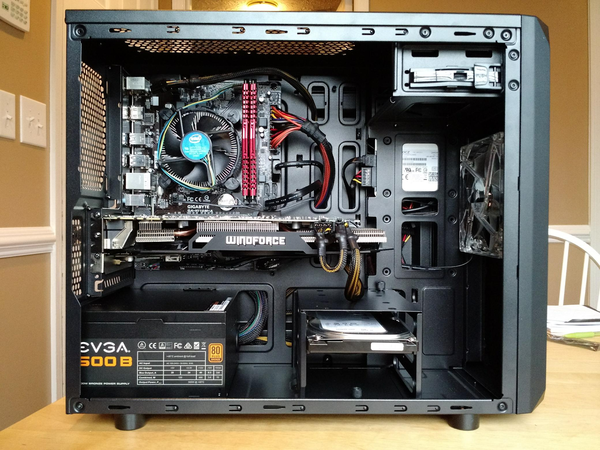
Or you can have a PC with your cables running every which way, blocking airflow and making you look like a total noob:
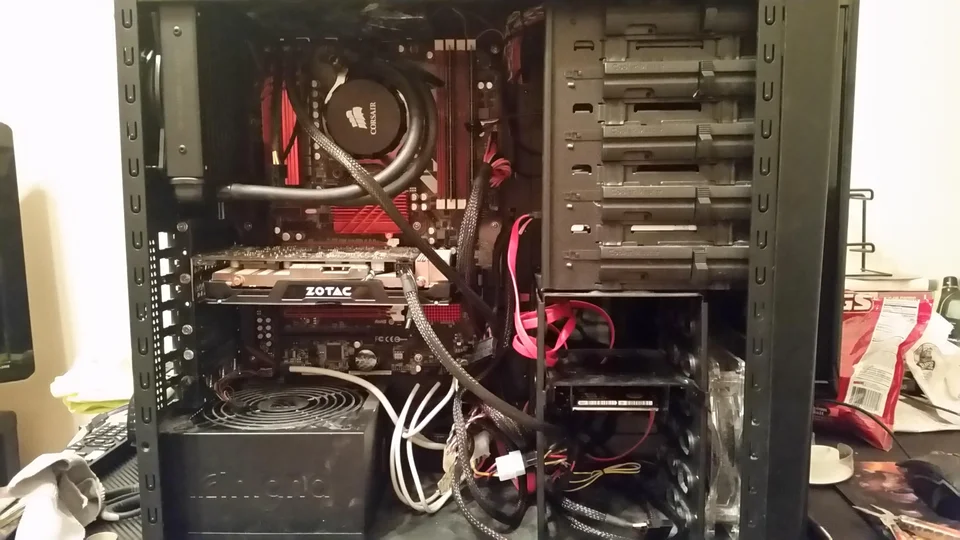
Using a modular power supply is one way to improve your cable management (see our page on modular power supplies) as well as zip-tying your cables together and hiding them away in your case.
But one of the best ways to manage your cables is by buying an awesome PC case with good cable management options in the first place!
Cable management is important if you want your PC to look clean and professional, but it actually doesn’t have a big impact on performance, or even airflow.
On our page about cable management and airflow, we explain in further detail and show some examples of good cable management vs bad cable management.
But for now, here’s what you need to know:
If your cables are all stuffed in your case, you’ve got a few problems on your hands. First of all, your cables will obstruct proper airflow. Secondly, anyone who looks at your gaming PC will be horrified by what they see! If you’re proud of your PC, keep your cables nice and tidy.
A good case for cable management isn’t all you’re going to need. Any skilled PC builder has a few cable management tools in their belt.
Here are some of our recommendations:
With your tools in hand and a good case, here are some of our best cable management tips:
As we mention in our cable management guide, it doesn’t have a big impact on performance, or even airflow. Cable management is almost purely for looks.
That being said, if you want your build to look awesome, you should have a battle plan in mind.
You don’t want to have a bunch of wires running diagonally all over the place, even if they’re tied together. Cables should only appear to run vertically and horizontally for the best aesthetic.
Don’t be afraid to map out your cable management plan on a piece of paper or the Paint application to get a better idea of what you’ll be doing.
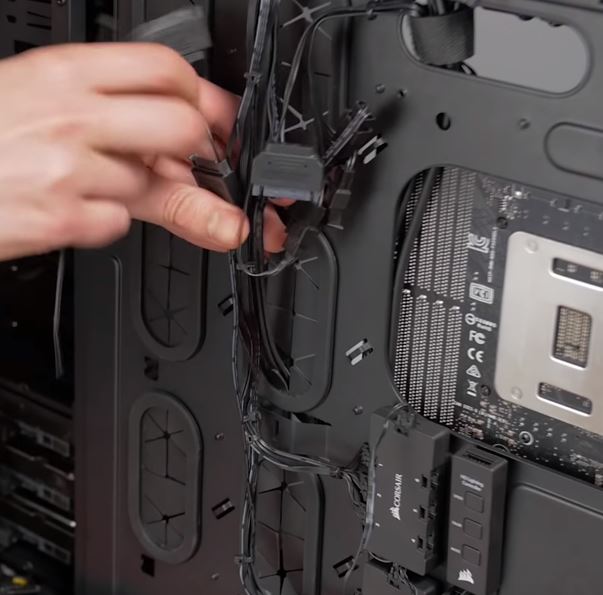
Assuming you already have your build assembled, move the large cables out of the way (probably motherboard and CPU power) so you can start working on the tiny cables.
These could be your case fan wires, audio cables, and some of the other cables that come with your case.
Use the small zip ties to clean them up, using existing case crevices to hide them, in addition to the empty spaces where DVD drives used to go. They make for great nooks to hide your front IO cables.
Since SATA data and power cables tend to be flimsy, you should save them for last.
They’re way more prone to breaking than the rest of the cables in your system, trust me…
When I was building my first budget gaming PC, I was trying to manage my cables in a crappy case. Instead of saving my SATA cables for last, I wired them up and tucked them away first. Unfortunately, I ended up snapping the connector and breaking it when it got snagged on another cable I was working with.
Moral of the story?
Don’t cable manage your SATA cables until the end!

Rotating your fans can often give a cleaner run to your fan connector.
Instead of having to run your cable across the fan, mount your case fan so that its cable originates closest to your fan power connector.
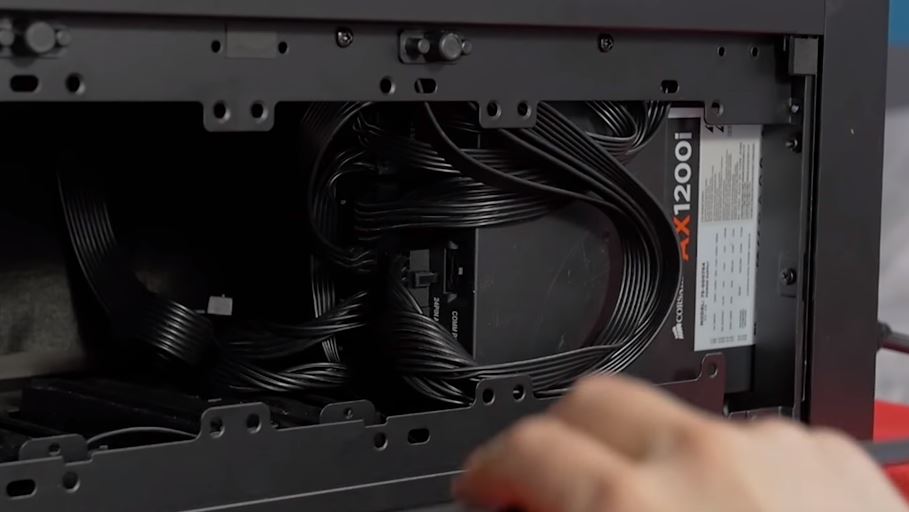
If you have a modular power supply, you can hide your cables in the cavity behind the PSU.
Luckily, the best cable management cases we listed above have power supply shrouds, making this step easy.
Here are some awesome cable management ideas that’ll save you time and energy:
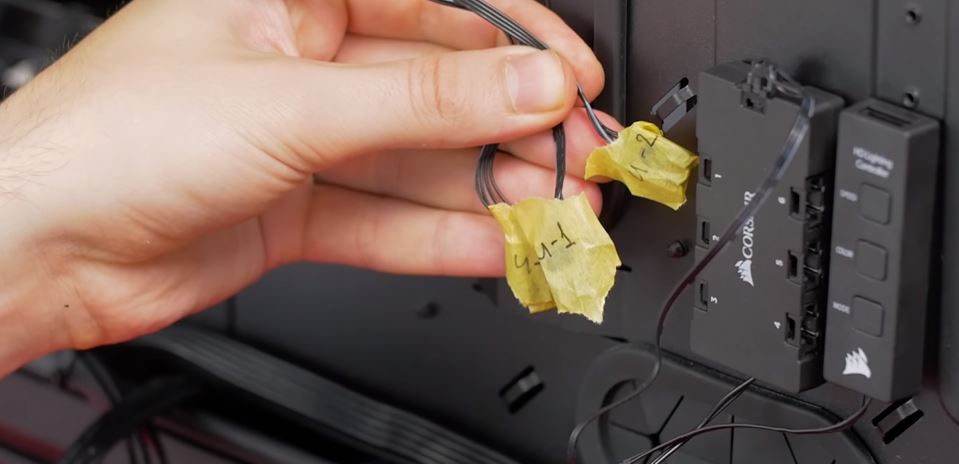
Labeling your fan power cables is going to make your life much easier when you want to reconfigure them in the future.
It will also help you reconfigure your RGB patterns when it’s no longer obvious which cable goes where.
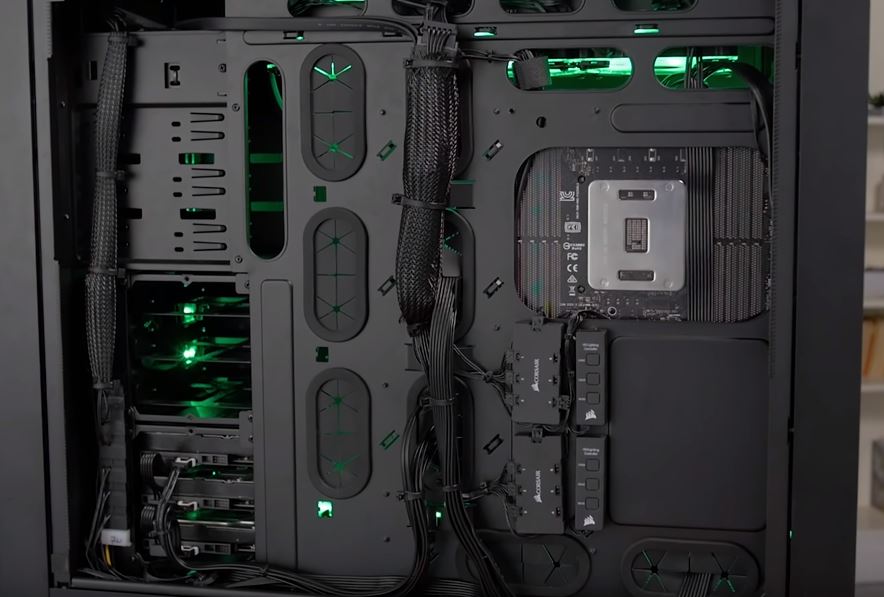
While running your small cables, think about where your main cables will (eventually) go.
You can use the large cables to hide the small ones later on using the cable mesh sleeve we mentioned in the tools section.
Planning rocks!
If your cables are a huge mess already, I’d recommend unplugging everything and starting from scratch.
You won’t have much luck managing cables that are poorly configured from the start.
Unplug them all, and use the tips/ideas above to do it properly.
Haven't yet got around to choosing the perfect cable management PC case? Check my top picks: